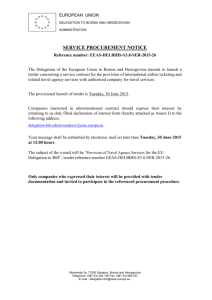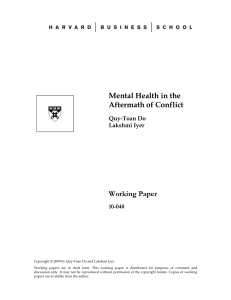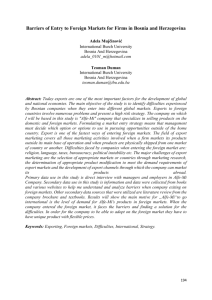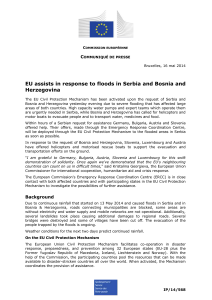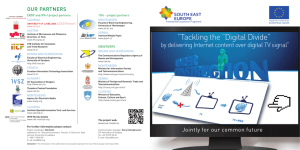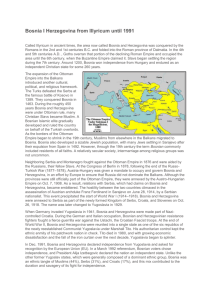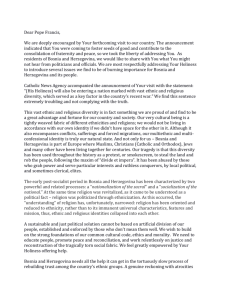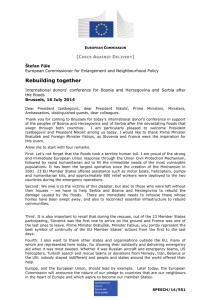Mental Health in the Aftermath of Conflict
advertisement
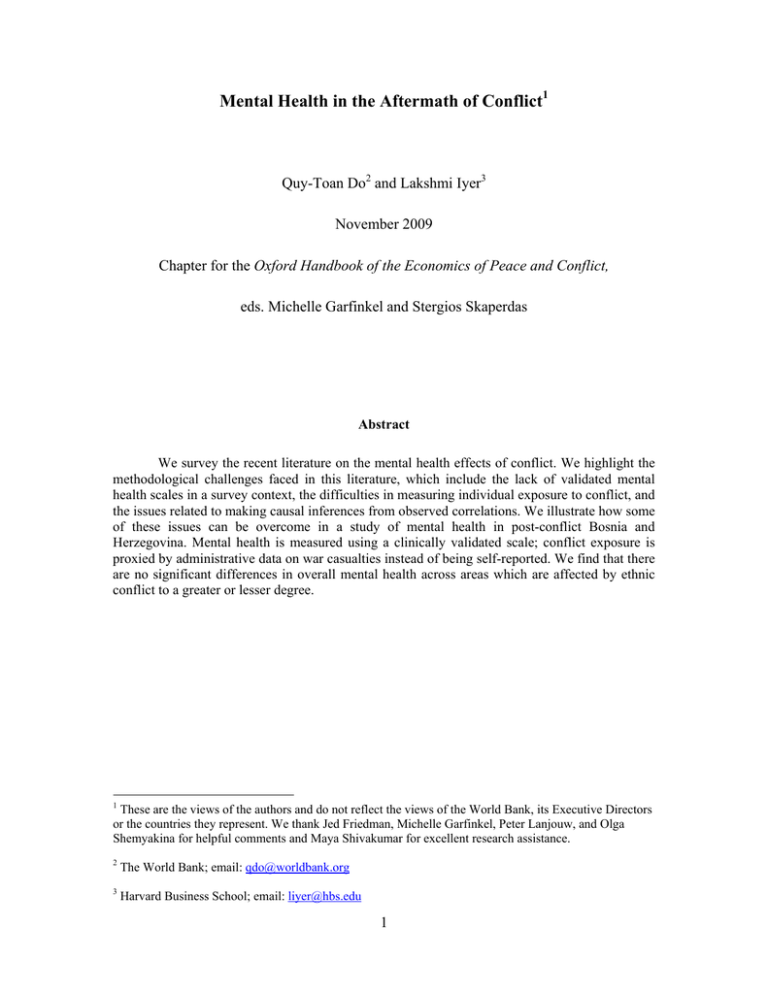
Mental Health in the Aftermath of Conflict1 Quy-Toan Do2 and Lakshmi Iyer3 November 2009 Chapter for the Oxford Handbook of the Economics of Peace and Conflict, eds. Michelle Garfinkel and Stergios Skaperdas Abstract We survey the recent literature on the mental health effects of conflict. We highlight the methodological challenges faced in this literature, which include the lack of validated mental health scales in a survey context, the difficulties in measuring individual exposure to conflict, and the issues related to making causal inferences from observed correlations. We illustrate how some of these issues can be overcome in a study of mental health in post-conflict Bosnia and Herzegovina. Mental health is measured using a clinically validated scale; conflict exposure is proxied by administrative data on war casualties instead of being self-reported. We find that there are no significant differences in overall mental health across areas which are affected by ethnic conflict to a greater or lesser degree. 1 These are the views of the authors and do not reflect the views of the World Bank, its Executive Directors or the countries they represent. We thank Jed Friedman, Michelle Garfinkel, Peter Lanjouw, and Olga Shemyakina for helpful comments and Maya Shivakumar for excellent research assistance. 2 The World Bank; email: qdo@worldbank.org 3 Harvard Business School; email: liyer@hbs.edu 1 1. Introduction Wars are detrimental to the populations and the economy of affected countries. Over and above the human cost caused by deaths and suffering during a time of conflict, survivors of conflict are often left in poor economic circumstances and mental health distress even after the conflict ends. How large are these costs? How long does it take for conflict-affected populations to recover from the mental stress of conflict? What policies are appropriate to assist mental health recovery? While considerable attention has been paid to post-war policies with regard to recovery in physical and human capital, mental health has received relatively less attention. In this chapter, we review the nascent literature on mental health in the aftermath of conflict. We believe that mental health is an outcome that deserves greater attention from scholars and policy makers alike.4 Mental health captures a dimension of individual welfare (or lack thereof) that is not perfectly correlated with alternative conventional outcome indicators such as poverty, consumption or income: for instance, Das et al. (2007, 2009) document an absence of correlation between mental health status and poverty in five developing countries. This result echoes the Easterlin paradox in the literature on happiness, which shows little correlation either within or across countries between the level of income and average happiness (Easterlin, 1974, 1995); in fact, the relationship between income and life satisfaction or happiness is a subject of considerable debate (see, among others, Deaton, 2008, and Stevenson and Wolfers, 2008). Furthermore, mental health is an important dimension of human capital. While economists have paid a great deal of attention to the effect of physical health on educational attainment and labor productivity (Maccini and Yang, 2009; Kremer and Miguel, 2004), little is known about the consequences of poor mental health on human capital or labor productivity. In the specific context of conflict, there are likely to be severe mental health consequences in addition to consequences for physical health or economic wealth. People exposed to conflict have often suffered personal injuries, experienced the loss of friends and relatives and witnessed violent events. Such mental health distress, while a matter of concern in and of itself, might also have adverse consequences for individuals’ labor force participation and labor productivity in the post-conflict period, thereby delaying economic recovery after the conflict ends. Quantifying the effect of conflict on mental health is therefore likely to be important for designing appropriate post-conflict policies for recovery. 4 World Bank (2009) provides a review of the existing literature in this field. 2 In this chapter, we review the methodological challenges that accompany attempts to measure the impact of conflict on mental health. First, we review typical survey instruments used to measure mental health status, and discuss the potential problems related to the use of mental health scales in cross-sectional analyses. The benefit of mental health measures, compared to alternative measures of well-being such as happiness or life satisfaction surveys, is that their ability to predict anxiety or clinical depression can be assessed. The current scarcity of data on this topic can be mitigated by the systematic inclusion of mental health modules in multi-purpose household surveys such as Living Measurement Standards Study (LSMS) surveys, together with sustained efforts to validate the mental health scales. Second, we summarize the measures of conflict typically used in the literature. We emphasize the limitations of using subjective assessments of conflict intensity elicited in a survey context because of potential recall biases; these biases are likely to be greater in the study of mental health, since mental health status might itself affect the respondents’ ability to recall events accurately. Third, we discuss the special problems of causal inference in this context. Conflicts are associated with large population displacements, which can lead to systematic biases in both the composition of the survey respondents, as well as in their reported mental health. In fact, the links between migration and mental health can be a fruitful area of research. Further, conflicts often occur in places that are subject to other risk factors for mental health distress (e.g. in socially polarized places), implying that a positive association between conflict intensity and mental health status does not necessarily establish a causal impact of the former on the latter. Fourth, we discuss the potential mechanisms through which conflict might affect mental health. Conflict might affect individuals’ expectations about the future, memories of past traumatic events can hamper people’s ability to recover from the conflict, or the hardship of postconflict reconstruction might itself be a source of stress. While the medical literature almost exclusively emphasizes the second channel, a good understanding of the obstacles to mental health recovery is instrumental to the proper design of post-conflict reconstruction policies. We review the current empirical literature in terms of how well it is able to address these conceptual and empirical concerns, and emphasize that these concerns also apply to impact evaluations of post-conflict reconstruction policies. Finally, we illustrate the findings from our study of mental health in a specific post- 3 conflict setting: Bosnia and Herzegovina. Our methodology avoids some of the typical empirical difficulties described earlier: for instance, we rely on objective measures of conflict from an international organization rather than subjective assessments based on respondents’ memories, and our mental health measures have been medically validated. We find, somewhat surprisingly, that there are no significant differences in overall mental health across people who experienced different levels of exposure to the conflict, though exposure to conflict does increase the probability that the respondent will recall the traumatic events of the war. This suggests that any mental health effect of conflict is most likely due to the backward-looking mechanism i.e. through recall of traumatic events. Even this latter difference disappears three years later, suggesting that relative recovery from the mental health effects can happen over time. We also find that people with more education, as well as those who move to a different locality after the conflict, suffer fewer conflict-related mental health consequences. The rest of the chapter is structured as follows: Section 2 reviews the data, measurement and inference challenges in assessing the relationship between conflict and mental health, Section 3 presents the analysis for Bosnia and Herzegovina, and Section 4 concludes with strategies to further the research agenda in this field. 2. Assessing the Impact of Conflict on Mental Health Addressing the important question of the impact of conflict on mental health presents methodological challenges that we review in this section. These fall under two broad categories: problems related to measurement and comparison issues in the existing data on mental health and conflict intensity, and problems related to the interpretation of observed associations between conflict and mental health. We discuss each of these in some detail.5 2.1 Measuring Mental Health Most studies in the literature construct a measure of mental health obtained from aggregation of 5 Note that these issues are not unique to the mental health and conflict literature, but are rather generic to micro-economic analyses of the aftermath of conflict. For a review of the literature, see Blattman and Miguel (2009). 4 responses to questionnaires administered in survey setting (for a review, see Das et al., 2007, 2009). These survey instruments share some common features. They typically ask survey respondents about their internal states (“feeling sad”, “feeling worthless”, etc.) and associated behaviors (“crying for no reason”, “having nightmares”, etc.). The answers are subjective assessments of the frequency or salience of a given internal state or behavior, on a 3-5 category Likert (1932) scale, such as “often”, “very often”, “sometimes”, “never”, or “always.” Appendix 1 shows the complete list of questions asked to survey respondents in Bosnia and Herzegovina in 2001. The survey questionnaires are generally adapted to various cultural settings, and several researchers have made efforts to check for internal consistency of the survey instruments (see Wittchen, 1994, and Smith et al., 2007). When warranted by the context, Post-Traumatic Syndrome Disorders (PTSD) items have been more systematically added as a complement to existing depression or anxiety scales.6 The Harvard Trauma Questionnaire (Dubois et al., 2004, Lopes Cardozo et al., 2000, and Mollica et al., 1999, among others) and the PTSD Checklists (Terhakopian et al., 2008, Pham et al., 2004) are the main survey instruments used to assess the prevalence of PTSD in the population following tragic events such as personal victimization, wars, natural disasters or economic crises. Similarly to other mental health scales, these scales are self-reported measures. Given that almost all mental health survey data are based on subjective assessments, there is a concern that answers to these questions may not be perfectly comparable across individuals. Whether an event is perceived as “frequent”, or a statement perceived as “mostly true,” can depend on the individual’s internal reference points, which are arguably correlated with socioeconomic status, occupation, ethnic or cultural identity, or other independent variables in the analysis. Cultural adaptation of the survey instruments is aimed at tailoring a questionnaire to a specific country rather than accounting for local cultural differences within a country. This caveat 6 Depression and anxiety are common psychological morbidities not necessarily due to a specific event but related to genetic predisposition and environmental factors. There is some overlap in their expression but also divergence. For instance, anxiety disorder often involves the avoidance of anxiety inducing situations (agoraphobia for example), while depression often involves low motivation. PTSD is event-related and involves in some way rumination or avoidance of the traumatic event, and the triggering of key symptoms/morbidities when reminded of the event. It often resolves naturally over time but not for everyone, particular those predisposed to anxiety. Symptoms of PTSD may be congruent with depression or anxiety so a general mental health survey module can pick up PTSD morbidities that overlap with depression or anxiety. 5 also applies to survey instruments aimed at capturing other subjective measures of well-being (see Di Tella and Mac Culloch, 2006, for a review of the literature on the economics of happiness). Nevertheless, as opposed to happiness and life satisfaction scales, mental health measures can be validated against well-defined objectives; in particular, their ability to predict clinical depression, anxiety or other mental disorders can be tested. Such an exercise was conducted in the context of three rounds of Bosnia and Herzegovina’s Living Standards Measurement Study (LSMS) survey. Radloff’s (1977) Center of Epidemiological Studies Depression (CESD) Scale was administered to a nationally representative sample of the population. To validate the CESD, a sample of 184 patients who visited primary health care facilities in a canton of Middle Bosnia and Herzegovina were administered the survey module and underwent a psychological diagnosis. A 1.86 threshold used to assess depression was found to have 97.5 percent sensitivity and 75 percent specificity rates (Kapetanovic, 2004).7 These CESD scales will constitute the main outcome variables in the analysis we will conduct in Section 3. While such validations are crucial in assessing the accuracy of mental health measures from surveys, formal validations in clinical setting do have some limitations. They are performed on a selected sample of care-seekers, and validation gives a threshold with associated specificity and sensitivity numbers that apply to the population as a whole, while there might be considerable heterogeneity across groups. Consequently, the measurement of well-being by eliciting preferences or feelings (as opposed to observing actions, such as actual consumption, investments or savings decisions) still has numerous caveats that call for a careful interpretation of results; further validation studies should nonetheless be encouraged. A more systematic inclusion of mental health scales in multi-purpose household surveys will certainly facilitate efforts towards that aim. 2.2 Measuring Exposure to Violent Conflict A large number of studies in the medical literature have relied on individual self-reported conflict exposure. An issue that has interested researchers is the association between mental health status 7 Sensitivity is the probability that a binary test delivers a positive result when the individual is actually sick (one minus the probability of a false negative or type II error); specificity is the probability that a binary tests delivers a negative result when the individual is actually not sick (one minus the probability of false positive or type I error). 6 and self-assessed exposure to past violence. Many studies use self-reported measures of traumatization, as measured by the Harvard Trauma Questionnaire, for instance. While the association between accounts of past traumatic events and symptoms of anxiety and depression is of independent interest, the potential recall bias affects the ability to make a causal inference of conflict on mental status. In particular, individuals suffering from depression or anxiety might be less prone to “move on” and thus may be more likely to recall past traumatic events. Such a problem might also affect other studies of the impact of conflict on mental attitudes and trust following the conflict. One instance is Bellows and Miguel (2009), who average household selfreported answers to four conflict-related questions to form a chiefdom-level measure of conflict intensity in Sierra Leone. In the analysis of the impact of conflict on welfare, many social scientists have instead used secondary sources of data on conflict (see e.g. Akresh and de Walque, 2008 or Shemyakina, 2009). The number of casualties or assessments of physical destruction are often reported by either non-governmental organizations or government institutions. In Nepal, the Informal Sector Service Center (INSEC) reports the number of casualties of the Maoist insurgency in various Human Rights Yearbooks (Do and Iyer, 2009). In the study of Bosnia and Herzegovina presented in this chapter, data on war casualties have been made available by the Sarajevo Research and Documentation Center (http://www.idc.org.ba/). An important initiative worth highlighting is the Correlates of War Project that was initiated in 1963 by scholars at the University of Michigan (http://www.correlatesofwar.org/). This project has allowed an impressive wealth of information on inter, extra and intra-State wars and militarized disputes spanning the time period 1816-2001 to be made publicly available for the benefit of the scientific community as a whole. While these measures are certainly more objective than self-reported conflict exposure, they do have some limitations. First, administrative records or official information might differ substantially from what is actually experienced on the ground. Such classical measurement error is likely to affect the precision of estimates. Second, local surveys of war casualties are not immune to non-classical measurement errors. For example, it might well be possible that the accuracy of reports of war damages depends on several factors (such as local governance, levels of economic development, and more broadly social capital) that in turn have an effect on mental health of the population. Thus, analyses of the association between reported war damages and subsequent mental health status must take the possibility of biased reports into account when interpreting empirical findings. 7 Last but not least, measures of community-level conflict intensity are meaningful only under the assumption that individuals were actually residing in the community they are being assigned to at the time violence occurred. Since wars are often associated with population displacements, such an assumption is not innocuous. In our study of Bosnia and Herzegovina, this problem is mitigated by the fact that the LSMS survey identifies for each survey respondent the commune of residence at the time of conflict. Furthermore, the displaced likely constitute a selected sample of the overall population. Such selective migration is often hard to control for, though some researchers have made efforts in this direction. For instance, in their study of Ugandan child soldiers, Blattman and Annan (2009) attempt to correct for selective attrition by estimating attrition probabilities based on observables. 2.3 Establishing a Causal Link between Conflict Exposure and Mental Health Researchers and policy makers are interested in three main questions: (i) How large is the causal impact of war on the mental health of affected populations? (ii) How fast is recovery, if any at all?, and (iii) What are the mechanism(s) underlying recovery or the absence thereof? Most studies in the literature rely on cross-sectional comparisons of mental health status levels between two individuals within the same country, who are exposed to varying conflict intensity. By construction, this comparison cannot assess any “aggregate impact” of the conflict as a whole. This is important because even individuals who are not directly exposed to the conflict are seldom psychologically unaffected. Thus, cross-sectional comparisons allow addressing the question of the heterogeneity of war impacts across the population, but leaving unanswered the question of overall impact of the war, when the counterfactual is peace. The problem becomes even more salient when no individual has been spared by the conflict, as has been assumed by Pham et al. (2004) in the case of Rwanda. We should note that this issue is not unique to cases where mental health is the outcome of interest. Within-country studies of the impact of conflict on health or economic development also cannot identify the aggregate effect of conflict without further (and arguably strong) assumptions.8 In particular, the absence of observed heterogeneity in outcomes across areas 8 See Bellows and Miguel (2009), Kondylis (2009), Do (2009), and Brakman, Garretsen and Schramm (2004), Davis and Weinstein (2002), and Miguel and Roland (2006) for estimates of the impact of conflict on respectively, trust and political participation, labor market participation, health and economic growth. 8 differently affected by conflict cannot be interpreted as evidence of “full” recovery or of low impact of the conflict, since these results can be driven by convergence across regions due to differential rates of economic recovery, and also insurance mechanisms or government transfers of resources across regions. Blattman and Miguel (2009) conduct a thorough review of the existing literature. If we want to have an estimate of the aggregate costs of conflict, we would need to use cross-country data. When mental health is the outcome of interest, current survey instruments are context-specific and therefore difficult to compare across countries, and current data availability does not allow for large enough sample sizes for such an attempt to even be considered. Finally, as in any observational study, the impact of conflict on mental health requires dealing with the causal interpretation of conditional correlations. Similar to the incidence of conflict across countries, the spread of conflict within a country also depends on local conditions such as geography, infrastructure or more generally economic development levels (see Do and Iyer, 2009). To the extent that unobservable risk factors of anxiety and depression are also risk factors of violence, causal inference is difficult to make from cross-sectional comparisons only. 2.4 Understanding the Mechanisms that Link Conflict Exposure and Mental Health A reduced-form association between conflict exposure and mental health confounds several channels that call for very different policy implications. The implicit assumption made in the medical literature on the mechanisms that link exposure to violent conflict and mental health is essentially backward looking: memories of past traumatic events are having long-term effects on individuals’ current mental health. PTSDs are viewed as the main factor underlying persistently low levels of mental health in the aftermath of conflict. Assistance to traumatized individuals to help them overcome past exposure to violence becomes a natural policy response in such circumstances. However, an association between exposure to violence and mental health status can also be driven by present-day circumstances. For instance, exposure to violence may be correlated with the loss of an income earner in the household, or simply wealth losses. Such a decline in the standard of living might then lead to poor mental health status. This economic view implies that economic recovery would largely contribute to improving mental health status in the aftermath of 9 conflict. Finally, there could be forward-looking impacts, in that conflict exposure can change people’s mindset regarding trust in the government, willingness to cooperate with others, or expectations about a better future. Such changes in mindset can result in worse mental health selfreports. The empirical evidence on mental health in the aftermath of natural disasters and economic crises suggests that the backward-looking view is the most likely mechanism. De Mel, Woodruff and Mackenzie (2008) find that mental health recovery after the 2004 tsunami depends mostly on the time elapsed since the disaster, and not on the recovery of an individual’s livelihood. Friedman and Thomas (2008) also find that in the aftermath of the 1997-98 East Asian crisis, mental health did not recover, even when income recovered to its pre-crisis level. These results are consistent with a backward looking view of emotional distress; the loss of a household member due to excess mortality due to the crisis may also be at the root of the observed persistence of emotional distress. The mechanisms that underlie the impact of exposure to conflict on mental health status deserve further investigation, as they determine appropriate policies for post-war reconstruction. However, evaluating impact of existing aid policies on recovery faces empirical challenges. Reconstruction and reconciliation efforts are more likely to be targeted to areas or populations that have suffered more from war. This “endogeneity” of aid programs makes it difficult to disentangle the effect of aid itself from other factors – e.g. conflict violence – that determined the placement and magnitude of post-war reconstruction aid. 3. Economic Recovery and Mental Health in Post-Conflict Bosnia and Herzegovina We estimate the relationship between conflict intensity and mental health in the aftermath of the conflict in Bosnia and Herzegovina (henceforth BiH). While we are able to overcome some of the measurement challenges described above, we cannot fully address all the potential interpretation issues, most notably the issue of selective migration. 10 3.1 Historical Background of the Conflict The conflict in BiH took place against the backdrop of the disintegration of Yugoslavia. After President Tito died in 1980, power began to be held by an unstable collective rotating presidency shared among the leaders of six republics (Serbia, Montenegro, Bosnia and Herzegovina, Croatia, Slovenia, and Macedonia) and two autonomous regions (Kosovo and Vojvodina). Multi-party elections were held in BiH in November 1990. Disagreements on the reform of the Yugoslav federation eventually induced Slovenia and Croatia to seek independence in 1991. In a 1992 referendum, the people of BiH voted overwhelmingly for independence from Yugoslavia. Bosnia declared independence on March 5, 1992, and was recognized by the United States and the European Community in April. Following the declaration of independence, all major Bosnian cities were blockaded by Bosnian Serbs, and the Serb-controlled Jugoslav National Army (JNA) established control over 70 percent of the country. Areas of eastern and northwestern Bosnia saw fierce fighting during 1992 and 1993 between all three major groups in the country: Bosniaks (mostly Muslim), Serbs (mostly Orthodox Christian) and Croats (mostly Roman Catholic). Descriptive accounts suggest that the main reasons to engage in conflict were strategic or ethnically motivated: both Serb and Croat individuals were convicted of planning ethnic cleansing in an attempt to create ethnically homogeneous States (Burg and Shoup, 1999). This motivation would suggest that the fighting was most intense in the most diverse areas; indeed, we find that the areas with greater pre-war ethnic diversity had higher conflict intensities (results available upon request). In February 1994, the Bosniaks and the Croats signed a cease-fire agreement. In March 1994, US mediation produced an agreement between the Bosnian government and the Republic of Croatia to establish a federation consisting of all the territory controlled by the Bosniaks and the Croats, resulting in the creation of the Federation of Bosnia and Herzegovina (FBiH). The Srebenica massacre of July 1995 (where about 8000 Bosniaks were killed by Serb forces) led NATO to conduct a month-long bombing campaign against the Serbs. The war finally ended with the signing of the Dayton Peace Agreement on November 21, 1995. This agreement partioned BiH into the Federation of Bosnia and Herzegovina (FBiH), led by Bosniaks and Croats, and the Republika Srpska (RS), which was Serb-dominated. In 1996, the UNHCR estimated FBiH to have a population of 2.44 million and RS to have a population of 1.48 million. In our nationally representative survey, approximately 55 percent of the households are from FBiH. 11 The war in Bosnia took a heavy toll on the population. The most conservative estimates by the International Criminal Tribunal for the former Yugoslavia (ICTY) indicate that at least 102,000 people were killed during the conflict, and the UNHCR estimates that around 1.3 million people were displaced. After the peace agreement was signed, more than 1 million of the displaced people were “resettled” all over the country and by 2007, an estimated 460,000 returned to their place of origin (UNHCR, 2007). In 1996, 59 donor countries and organizations pledged $1.9 billion in support of the reconstruction effort. 3.2 Measuring Mental Health We construct our measures of mental health based on household survey data from the Living Measurement Standards Study (LSMS) survey in BiH.9 These surveys were conducted in four consecutive years (2001, 2002, 2003, and 2004). Consumption and income aggregates are available only in the 2001 and 2004 waves, while mental health questions were asked in 2001, 2003 and 2004. The 2001 survey was nationally representative and contained over 5,400 households and more than 9000 individuals. We have information on the mental health status of nearly 7000 individuals from the 2001 survey; approximately 63 percent of them were reinterviewed in 2004. In our results, we will present comparisons using the full sample, as well as comparisons using only panel observations. We construct consistent measures of mental health across the two waves using the questions which were common to both waves. These questions relate to having low energy, selfaccusation, and trouble with sleeping, feeling hopeless, feeling worried, feeling melancholic and feeling that “everything was an effort”. We find that in the 2001 survey, measures of mental health constructed using these 7 variables are highly correlated with the measures using the 14point CESD scale (the correlation is 0.96). In addition, as discussed in Section 2, the CESD scale has been validated, which constitutes an advantage over many other empirical studies. There was also a separate question asking how often the respondent remembered the painful events experienced during the war, measured on a four-point scale similar to the other mental health questions. Answers to that question are moderately correlated with the overall 9 These household surveys were carried out by the World Bank, UNDP and DfID in co-operation with the Institute for Statistics of Republika Srpska (ISRS), the Statistics Institute of the FBiH and the Agency for Statistics of BiH. 12 mental health measure (the correlation is 0.58). We have information on demographic characteristics such as age, gender, years of schooling and ethnicity of the survey respondents. 44 percent of the survey respondents were Serbs, 40 percent were Bosniaks and 14 percent were Croats. 52 percent of the individuals were female and 17 percent of the respondents had migrated to their current locality after the conflict began in 1991. We also extracted information on transfers received by households in the form of aid and other forms of government assistance. 28 percent of the respondents in the 2001 survey received some form of aid from the government.10 As is the case in most LSMS surveys, we have detailed information on household consumption patterns, which can be used to construct an overall consumption figure, adjusted for regional price differences across municipalities in each year. We find that per capita consumption increased by only 3 percent in nominal terms between 2001 and 2004. 3.3 Measuring the Intensity of Conflict We measure conflict intensity at the municipality level, using data from the Sarajevo Research and Documentation Center (RDC), which publishes regular updates on the number of missing or killed people in each of the municipalities of BiH. The data is also known as “the Bosnian Book of Dead Project 1991-1995”, or the “Human Losses in Bosnia and Herzegovina Project” (see Swee, 2009). The reliability of the data has been discussed Ball et al. (2007), who conclude that the “database is a unique and valuable source and deserves a prominent place among sources on victimization of the 1992-95 war in Bosnia and Herzegovina” (p. 59). We used the RDC data on the number of people missing or killed, combined with population data from the 1991 census to construct a measure of conflict intensity in each municipality. This measure is the number of casualties (missing or killed) per 100 inhabitants. The mean of this variable is 0.021 and it varies considerably across provinces from close to 0 to more than 0.10. The LSMS records information on the current municipality of residence, as well as municipality of residence before the war started. We can therefore match each individual to the level of conflict in their current municipality of residence, as well as that in their pre-war 10 We include amounts received as old age pension, invalid pension, survivors' pension, military pension, war disability benefit and funds from the Civil Victims of War. 13 municipality of residence.11 The former is different from the latter for the people who migrated as a result of the conflict. This is in contrast to other studies which use self-reported measures of conflict intensity (see Lopes Cardozo et al., 2000, 2004, Scholte et al., 2004, Dubois et al., 2004, Mollica et al., 1999, 2001). Since the conflict in Bosnia was driven primarily by ethnic motivations, we also control for the extent of ethnic diversity in the respondent’s current municipality of residence, since living in an ethnically polarized society might have direct effects on mental health or economic well-being. 3.4 Empirical Strategy The objective of this paper is to compare trajectories' of individuals heterogeneously affected by the conflict. The canonical equation that will be estimated is the following: (1) where is the outcome of interest for individual i at time t (with t=2001,2004), living in municipality j and who lived in municipality k before the war, and variables. The variable is a vector of control measures the intensity of conflict in individual i′s pre-war municipality of residence. Our main outcome variables are per capita consumption, labor force participation and measures of mental health. We first present the results of estimating equation (1) in levels for 2001. Our control variables include standard individual and household characteristics, including age, gender, years of education and ethnicity. Since outcomes can be correlated for people living in the same area, we cluster all the standard errors at the level of the current municipality of residence. We also run a specification where includes a measure of ethnic diversity in the current municipality of residence, as well as some information on the economic well-being of the respondent (whether he or she has a job and the current level of per capita household consumption). An important focus of the analysis is the heterogeneity of the relationship between conflict and outcomes described by (1). We interact the conflict intensity variable with demographic characteristics such as gender, age, ethnicity and schooling. We will therefore estimate an equation of the type 11 Kondylis (2009) and Swee (2009) also assign conflict data to individuals’ pre-war municipality of residence. 14 (2) Vector δ will indicate whether individuals' characteristics affect the association between conflict intensity and outcomes. 3.5 The Evolution of Mental Health in Post-Conflict Bosnia and Herzegovina We first observe a general deterioration in the mental health measures over time for the entire sample (Table 1). The average mental health score increased from 1.63 in 2001 to 1.91 in 2004, indicating deterioration in mental health levels. Some of this increase is due to the aging of the sample respondents; there is a considerable literature documenting that older people tend to suffer from worse mental health, and we find this in our cross-section regressions as well. Another potential hypothesis is that this worsening is caused by relatively lack-luster economic growth. Individuals who were exposed to higher levels of conflict have somewhat worse mental health measures than individuals who were exposed to lower levels of conflict, as measured by the 7-question measure (Table 2, panel A). These differences are not statistically significant, and are much smaller in 2004, suggesting that the greater passage of time does help in improving the overall mental health of conflict survivors. This is similar to the relationship documented for survivors of natural disasters (see e.g. van Griensven et al., 2006). In contrast to this lack of significant differences in overall mental health, we find that individuals who had a greater exposure to conflict continue to recall the bad experiences of the war much more frequently. This is readily apparent in the number of people who report that they recalled war experiences “extremely often” in the past week (Table 2, panel C). While this number remains steady over time for people in low-conflict areas, it increases for people in highconflict areas, and the difference between these groups of people remains statistically significant. All of these results remain similar when we use only the panel households. We then use equation (1) to see whether conflict-affected individuals are more likely to have worse mental health, after controlling for personal characteristics such as age, gender, ethnicity and education levels. We will also use (2) to see whether certain groups of individuals are more likely to be affected by conflict experiences. The regression format also allows us to employ a continuous measure of conflict exposure, rather than a binary dummy. We are also able 15 to look separately at people who migrated in response to conflict and those who did not. Our regression results are similar to those documented in Table 2: people who lived in conflict-affected municipalities before the war have a greater probability of recalling the war experiences, but we do not find any significant differences in overall mental health status across people with differing experiences of conflict (Table 3, Columns 1, 3, 5). These results are robust to controlling for factors such as the degree of ethnic polarization in the respondent’s area of residence in 2001, whether the respondent had a job in 2001, as well as the level of per capita consumption (Columns 2, 4 and 6). In common with other studies on mental health, our results also show that older people and women are significantly more likely to have worse mental health, while people with more education have better mental health. Croats are likely to have better mental health, compared to Bosniaks or Serbs; they are also characterized by higher consumption levels, which might in part explain the difference. The magnitude of these conflict-induced differences in mental health is not large. For instance, a one standard deviation increase in the experience of conflict is associated with a 0.065 standard deviation increase in the mental health score, and a 0.09 standard deviation increase in the frequency of recalling war experiences. In comparison, the impact of demographic measures is much larger: women have 0.21 standard deviations worse mental health, each additional year of age reduces mental health by 0.027 standard deviations (which translates into a 0.46 standard deviation decline for a one standard deviation increase in age) and each additional year of schooling improves mental health by 0.04 standard deviations (0.14 standard deviation improvement for a one standard deviation increase in years of education). The corresponding effects on the frequency of recalling war experiences are 0.59 standard deviations for a one standard deviation increase in age, and 0.17 for a one standard deviation increase in years of education. The regression results for 2004 show even smaller differences in mental health measures across areas exposed to different levels of conflict. All the coefficients are smaller in magnitude than in 2001. There are no significant differences in the 7-question mental health measure (Columns 7 and 8). People exposed to high levels of conflict are still very likely to recall their war experiences frequently (Column 9), but this seems to be driven primarily by the fact of living in an ethnically polarized municipality (Column 10). The coefficients on all demographic variables remain very similar. 16 Are certain groups more likely to suffer poor mental health as a result of conflict? For the same exposure to conflict, we find that people with more years of schooling had better mental health outcomes, those who migrated in response to the conflict recalled the war experiences less often, and Croats recalled those events more often compared to other ethnic groups (Table 4, Columns 1-3). None of these differential effects of conflict experience persists into 2004, with the exception for the coefficient on Croatian ethnicity (Table 4, Columns 4-6). Finally, we find that receiving aid is associated with faster mental health recovery (results not shown), but wish to emphasize that we are unable to rule out that this association is spurious and captures decreasing higher-order effects of conflict on mental health, since aid might (and should) be targeted towards high conflict areas. 4. Conclusions We discussed three major obstacles in empirically documenting the mental health effects of conflict: measurement, comparison and interpretation. Most large-scale household surveys do not contain information on mental health. Even if survey evidence is available, constructing a clinically validated mental health measure is often difficult. In terms of comparison, there are conceptual difficulties of respondent-specific internal scales of comparison, which may change over time. There are also difficulties in finding a suitable “control” group to assess the impact of conflict. Given that measuring mental health through surveys is a relatively new trend, there are often no pre-conflict measures to compare with, and the empirical studies therefore suffer from all the usual problems of cross-sectional analysis. In addition, a strict within-country comparison might completely miss an aggregate effect of the conflict on the whole country. Thus, finding that there are no significant differences between areas with high and low conflict (as in our study on Bosnia) cannot rule out the presence of large aggregate effects. The best way to resolve this empirical problem would be to include mental health measures in household surveys on a regular basis, similar to the inclusion of physical health modules in many surveys. Despite these major caveats, we do see some similar trends in this nascent literature. The first is that time since conflict does seem to lower the differences in mental health outcomes across people who experienced different intensities of conflict. However, the recovery paths of mental health need not follow the same time line as that of the recovery of economic activity or political developments. The second is that certain subgroups do appear to have lingering effects, 17 and these can provide guidance to focus government aid efforts. This brings us to the major unexplored theme in this literature: the mechanisms by which conflict experience translates into mental health status. Is it because of conflict-induced losses in income or standard of living? If so, then government aid programs should help. However, we do not find much evidence to support this in our study of Bosnia-Herzegovina. This can be a fruitful area of cooperation between economists, medical professionals and other social scientists going forward. 18 References Akresh, R., and D. de Walque, “Armed Conflict and schooling: Evidence from the 1994 Rwandan Genocide”, World Bank Policy Research Working Paper #4606, 2008 Ball, P., E. Tabeau, and P. Verwimp, “The Bosnian Book of Dead: Assessment of the Database”, Households in Conflict Network Research Design Note 5, 2007 Bellows, J. and E. Miguel, “War and Local Collective Action in Sierra Leone”, Journal of Public Economics, forthcoming, 2009 Blattman, C. and J. Annan, “The Consequences of Child Soldiering”, Review of Economics and Statistics, forthcoming, 2009 Blattman, C. and E. Miguel, “Civil War”, Journal of Economic Literature, forthcoming, 2009 Brakman S., H. Garretsen, and M. Schramm, “The strategic bombing of German cities during World War II and its impact on city growth”, Journal of Economic Geography, 4(2): 20118, 2004 Burg, S., and P. Shoup, “The War in Bosnia-Herzegovina: Ethnic Conflict and International Intervention”, M.E. Sharpe, 1999 Das, J., Q.T. Do, J. Friedman, D. McKenzie, and K. Scott, “Mental Health and Poverty: Revisiting the Relationship”, Social Science and Medicine, 65(3):467-80, 2007 Das, J., Q.T. Do, J. Friedman, and D. McKenzie, “Mental health patterns and consequences: results from survey data in five developing countries”, World Bank Economic Review, forthcoming, 2009 Davis, D., and D Weinstein, “Bones, Bombs, and Breakpoints: The Geography of Economic Activity”, American Economic Review, 92(5): 1269-89, 2002 Deaton, A., “Income, aging, health and wellbeing around the world: Evidence from the Gallup World Poll”, Journal of Economic Perspectives, 22(2): 53-72, 2008 De Mel, S., D. Mackenzie, and C. Woodruff, “Mental Health Recovery and Economic Recovery after the Tsunami: High-Frequency Longitudinal Evidence from Sri Lankan Small Business Owners,” Social Science and Medicine, 66(3): 582-95, 2008 Di Tella, R., and R. MacCulloch, “Some Uses of Happiness Data in Economics”, Journal of Economic Perspectives, 20(1):25-46, 2006 Do, Q.T., “Agent Orange and the Prevalence of Cancer in the Vietnamese Population 30 Years after the End of the War”, World Bank Policy Research Working Paper No. 5041, 2009 Do, Q.T., and L. Iyer, “Geography, Poverty, and Conflict in Nepal”, Journal of Peace Research, forthcoming, 2009 Dubois, V., P. Hoyois, K. Sunbaunat, J.P. Roussaux, and E. Hauff, “Household Survey of 19 Psychiatric Morbidity in Cambodia”, International Journal of Social Psychiatry, 50(2):174-185, 2004 Easterlin, R., “Does economic growth improve the human lot? Some empirical evidence”, in Nations and Households in Economic Growth: Essays in Honor of Moses Abramovitz, P. David and M. Reder (eds.) 89-125. New York: Academic Press, 1974 Easterlin, R., “Will raising the incomes of all increase the happiness of all?”, Journal of Economic Behavior and Organization, 27(1): 35-47, 1995 Esteban, J. and D. Ray, “On the Measurement of Polarization”, Econometrica, 62(4): 819-51, 1994 Friedman, J. and D. Thomas, “Mental Health Before, During and After an Economic Crisis: Results from Indonesia 1993-2000”, World Bank Economic Review, forthcoming, 2008 van Griensven, F., M.L.S. Chakkraband, W. Thienkrua, W. Pengjuntr, B. Lopes Cardozo, P. Tantipiwatanaskul, P. Mock, S. Ekassawin, A. Varangrat, C. Gotway, M. Sabin, J. Tappero, “Mental health problems among adults in Tsunami-affected areas in Southern Thailand”, Journal of the American Medical Association, 296(5): 537-48, 2006 Kapetanovic, A., “Validation of Depression and PTSD Scales used in the 2001 Living Standards Measurement Surveys (LSMS) in Bosnia and Herzegovina”, World Bank unplublished paper, 2004 Kondylis, F., “Conflict-Induced Displacement and Labor Market Outcomes: Evidence from PostWar Bosnia and Herzegovina”, World Bank unpublished paper, 2009 Kremer, M., and E. Miguel, “Worms: Identifying impacts on education and health in the presence of treatment externalities”, Econometrica, 72(1): 169-217, 2004 Likert, R., “A Technique for the Measurement of Attitudes”, Archives of Psychology, 140: 1-55, 1932 Lopes Cardozo, B., O.O. Bilukha, C.A. Crawford, I. Shaikh, M.I. Wolfe, M.L. Gerber and M. Anderson. “Mental health, social functioning, and disability in postwar Afghanistan”, Journal of the American Medical Association, 292:575-84, 2004 Lopes Cardozo, B., A. Vergara, F. Agani, and C.A. Gotway, “Mental health, social functioning, and attitudes of Kosovar Albanians following the war in Kosovo”, Journal of the American Medical Association, 284(5):569-577, 2000 Maccini, S., and D. Yang, “Under the weather: Health, schooling, and economic consequences of early-life rainfall”, American Economic Review, 99(3):1006-26, 2009 Miguel, E. and G. Roland, “The Long-Run Impact of Bombing Vietnam”, manuscript, UC Berkeley, 2006 Mollica, R. F., K. McInnes, N. Sarajlic, J. Lavelle, I. Sarajlic, and M. P. Massagli, “Disability associated with psychiatric comorbidity and health status in Bosnian refugees living in Croatia”, Journal of the American Medical Association, 282:433-9, 1999 20 Mollica, R.F., N. Sarajlic, M. Chernoff, J. Lavelle, I. S. Vukovic and M.P. Massagli, “Longitudinal study of psychiatric symptoms, disability, mortality, and emigration among Bosnian refugees”, Journal of the American Medical Association, 286:546-54, 2001 Montalvo, J. and M. Reynal-Queyrol, “Ethnic Polarization, Potential Conflict and Civil War”, American Economic Review, 95(3): 796-816, 2005 Pham, P.N., H.M. Weinstein, and T. Longman, “Trauma and PTSD Symptoms in Rwanda: Implications for Attitudes Toward Justice and Reconciliation”, Journal of the American Medical Association, 292:602-612, 2004 Radloff, L.S., “The CES-D scale: A self-report depression scale for research in the general population”, Applied Psychological Measurement, 1:385-401, 1977 Ringdal, G.I., K. Ringdal, and A. Simkus, “War Experiences and War-Related Distress in Bosnia and Herzegovina Eight Years after War”, Croatian Medical Journal, 49:75-86, 2008 Scholte, W.F., M. Olff, P. Ventevogel, G. de Vries, E. Jansveld, B. Lopes Cardozo, and C.A. Gotway Crawford, “Mental Health Symptoms Following War and Repression in Eastern Afghanistan”, Journal of the American Medical Association, 292:585-93, 2004 Shemyakina, O., “The Effect of Armed Conflict on Accumulation of Education: Results from Tajikistan”, Households in Conflict Network Working Paper #12, 2009 Smith, T.C., B. Smith, I.G. Jacobson, T.E. Corbeil, and M.A. Ryan, “Reliability of standard health assessment instruments in a large, population-based cohort study”, Annals of Epidemiology, 17:525-32, 2007 Stevenson, B., and J. Wolfers, “Economic growth and subjective well-being: Reassessing the Easterlin paradox”, NBER working paper 14282, 2008 Swee, E.L., “On War and Schooling Attainment: The Case of Bosnia and Herzegovina”, Households in Conflict Network Working Paper #57, 2009 Terhalopian, A., N. Sinaii, C.C. Engel, P.P. Schnurr, and C.W. Hoge, “Estimating population prevalence of post-traumatic stress disorder: an example using PTSD checklist”, Journal of Traumatic Stress, 21(3):290-300, 2008 UNHCR, “Statistics Package,” 2007. http://www.unhcr.ba/updatejuly/SP_06_2007.pdf, accessed January 2008. Witchen, H-U, “Reliability and validity studies of the WHO Composite International Diagnostic Interview (CIDI): A critical review.” Journal of Psychiatric Research, 28:57-84, 1994 World Bank, “Mental Health, Conflict and Development: An Annotated Bibliography”, 2009 21 Appendix 1: Mental Health Survey Questions in Bosnia and Herzegovina 2001 LSMS: Module 4, Part B: Health Status (Questions 9-24) 9. During previous week, including today, how many times did you feel low in energy, slowed down? (Not at all…1; A little…2; Quite a bit…3; Extremely often…4) 10. During previous week, including today, how many times did you accuse yourself for different things? (Not at all…1; A little…2; Quite a bit…3; Extremely often…4) 11. During previous week, including today, how many times did you start easily weeping? (Not at all…1; A little…2; Quite a bit…3; Extremely often…4) 12. During previous week, including today, how many times did you feel lost of appetite? (Not at all…1; A little…2; Quite a bit…3; Extremely often…4) 13. During previous week, including today, how many times did you have problems falling asleep or sleeping? (Not at all…1; A little…2; Quite a bit…3; Extremely often…4) 14. During previous week, including today, how many times did you feel hopeless in terms of future? (Not at all…1; A little…2; Quite a bit…3; Extremely often…4) 15. During previous week, including today, how many times did you feel melancholic? (Not at all…1; A little…2; Quite a bit…3; Extremely often…4) 16. During previous week, including today, how many times did you feel lonely? (Not at all…1; A little…2; Quite a bit…3; Extremely often…4) 17. During previous week, including today, how many times did you think about ending your life? (Not at all…1; A little…2; Quite a bit…3; Extremely often…4) 18. During previous week, including today, how many times did you feel as if you were trapped or captured? (Not at all…1; A little…2; Quite a bit…3; Extremely often…4) 19. During previous week, including today, how many times did you feel that you worried to much about different things? (Not at all…1; A little…2; Quite a bit…3; Extremely often…4) 20. During previous week, including today, how many times did you feel that you were not interested in your surroundings? (Not at all…1; A little…2; Quite a bit…3; Extremely often…4) 21. During previous week, including today, how many times did you feel that everything was an effort? (Not at all…1; A little…2; Quite a bit…3; Extremely often…4) 22. During previous week, including today, how many times did you feel worthless? (Not at all…1; A little…2; Quite a bit…3; Extremely often…4) 23. During previous week, including today, how many times did you constantly recall most painful events you experienced during the war? (Not at all…1; A little…2; Quite a bit…3; Extremely often…4) 24. During previous week, including today, did you constantly have nightmares? (Not at all…1; A little…2; Quite a bit…3; Extremely often…4) The 2002 LSMS does not contain a mental health module The 2003 and 2004 LSMS ask questions 10, 13, 14, 15, 19, 21, and 23. 22 Table 1: Mental Health Outcomes in Bosnia, 2001 and 2004 Did you feel low in energy? Did you accuse yourself for different things? Did you have problems falling asleep or sleeping? Did you feel hopeless in terms of the future? Did you feel melancholic? Did you feel that worried too much about different things? Did you feel that everything was an effort? Did you constantly recall the most painful events you experienced during the war? Mental health (7-question measure) Recalled war experiences "extremely often" 2001 #obs 6437 6439 6439 6439 6440 Mean 1.664 1.380 1.551 1.707 1.617 2004 #obs 4482 4473 4482 4466 4480 Mean 1.886 1.655 1.747 2.033 1.904 6438 6440 1.889 1.592 4480 4479 2.172 1.987 6441 1.769 4481 1.890 6441 6441 1.629 0.077 4483 4481 1.913 0.080 Table 2: Do high-conflict households have worse mental health measures? 2004 2001 Panel A: Mental health, 7-question measure Low-conflict areas 1.571 1.895 High-conflict areas 1.769 1.962 0.197 (0.147) 0.130 (0.132) 0.067 (0.060) 0.068 (0.059) Difference Difference (panel households) Panel B: Frequency of recalling war experiences Low-conflict areas 1.671 1.808 High-conflict areas 2.002 2.101 0.33 (0.202) 0.212 (0.174) 0.293** (0.099) 0.295** (0.098) Difference Difference (panel households) Panel C: Recall war experiences extremely often Low-conflict areas 0.057 High-conflict areas Difference Difference (panel households) 0.06 0.124 0.132 0.067 (0.042) 0.037* (0.022) 0.072** (0.034) 0.073** (0.034) Robust standard errors in parantheses, corrected for clustering at the level of the municipality of residence. * indicates significance at 10% level, ** at 5% level and *** at 1% level. Table 3: Conflict exposure and mental health outcomes (Regression analysis) 2001 Mental health (7question measure) (1) (2) Conflict intensity 1.652 1.446 (1.186) (1.160) Age 0.017*** 0.022*** (0.004) (0.005) Age-squared -0.007 -0.012** (0.005) (0.005) Female 0.130*** 0.118*** (0.023) (0.027) Serb 0.113 0.095 (0.099) (0.079) Croat -0.373*** -0.381*** (0.085) (0.090) Years of schooling -0.026*** -0.017* (0.007) (0.008) Ethnic polarization in -0.077 commune of residence (0.190) Respondent has a job -0.120*** (0.028) Log(per capita consumption) -0.105** (0.045) Observations R-squared 5702 0.23 5696 0.25 2004 Frequency of recalling war experiences (scale of 1-4) (3) (4) Recalled war experiences very often (5) (6) 3.491* (1.896) 0.033*** (0.009) -0.027** (0.010) -0.002 (0.043) 0.143 (0.155) -0.503*** (0.136) -0.032** (0.012) 3.356* (1.889) 0.038*** (0.010) -0.033*** (0.010) -0.024 (0.044) 0.172 (0.140) -0.472*** (0.143) -0.030** (0.012) 0.157 (0.290) -0.098* (0.052) -0.000 (0.052) 0.813* (0.424) 0.004 (0.003) -0.003 (0.003) 0.001 (0.010) 0.030 (0.030) -0.036* (0.019) -0.006* (0.003) 0.842* (0.450) 0.005* (0.003) -0.004 (0.003) -0.003 (0.010) 0.029 (0.026) -0.045* (0.023) -0.006* (0.003) -0.025 (0.055) -0.020** (0.009) 0.023 (0.015) 5702 0.12 5696 0.12 5702 0.04 5696 0.04 Robust standard errors in parantheses, corrected for clustering at the level of municipality of residence. * significant at 10%; ** significant at 5%; *** significant at 1% Mental health (7question measure) (7) (8) 0.181 -0.353 (0.707) (0.772) 0.024*** 0.027*** (0.004) (0.004) -0.013** -0.016*** (0.005) (0.005) 0.158*** 0.154*** (0.018) (0.018) 0.066 0.083* (0.050) (0.049) -0.268** -0.252** (0.110) (0.103) -0.027*** -0.021*** (0.005) (0.004) 0.166 (0.121) -0.086*** (0.022) -0.152*** (0.052) 3976 0.21 3947 0.23 Frequency of recalling war experiences (scale of 1-4) (9) (10) Recalled war experiences very often (11) (12) 3.338** (1.585) 0.028*** (0.006) -0.024*** (0.007) -0.040 (0.044) 0.145 (0.097) -0.442** (0.179) -0.023*** (0.007) 2.337 (1.451) 0.029*** (0.006) -0.025*** (0.007) -0.031 (0.051) 0.213** (0.094) -0.362** (0.151) -0.022** (0.008) 0.481** (0.200) 0.013 (0.075) -0.152 (0.095) 0.572 (0.397) 0.003 (0.002) -0.002 (0.002) 0.001 (0.008) 0.046 (0.029) -0.019 (0.022) -0.004* (0.002) 0.496 (0.398) 0.003* (0.002) -0.003 (0.002) 0.001 (0.011) 0.041* (0.024) -0.026 (0.026) -0.002 (0.003) -0.009 (0.050) -0.020 (0.018) -0.028 (0.024) 3974 0.08 3945 0.10 3974 0.02 3945 0.02 Table 4: Are some people affected more by conflict than others? Mental health (7question measure) (1) Conflict intensity Conflict * migrant Conflict * returnee Conflict * age Conflict * female Conflict * Serb Conflict * Croat Conflict * Schooling Observations R-squared Frequency of recalling war experiences (scale of 1-4) (2) Mental health (7question measure) (4) Frequency of recalling war experiences (scale of 1-4) (5) Recalled war experiences very often (3) 3.362 (5.747) 0.632 (3.971) 3.624 (5.992) 0.036 (0.039) 0.177 (0.828) 3.487 (4.156) 20.723*** (5.618) -0.531** (0.203) 21.764*** (7.641) -11.825** (5.390) -16.645 (9.951) 0.045 (0.044) 0.112 (1.321) -8.656 (6.552) 14.652** (6.310) -1.070*** (0.270) 5.346** (2.330) -2.845* (1.424) -3.394 (3.018) 0.013 (0.014) 0.124 (0.317) -1.294 (1.286) -0.883 (1.494) -0.285** (0.121) -2.139 (3.938) 2.421 (2.670) -0.784 (2.423) 0.024 (0.039) -0.821 (1.464) 0.403 (2.370) 23.492*** (6.051) -0.070 (0.224) -0.669 (8.048) -7.386 (5.669) -8.451 (9.460) 0.125 (0.088) 1.547 (1.749) -10.650 (6.593) 34.188** (12.794) 0.450 (0.341) -0.650 (1.732) -0.110 (1.626) -0.798 (2.805) 0.025 (0.024) -0.240 (0.546) -0.702 (1.738) 2.656 (2.007) 0.046 (0.087) 5702 0.25 5702 0.14 5702 0.05 3976 0.23 3974 0.13 3974 0.03 Robust standard errors in parantheses, corrected for clustering at the level of municipality of residence. * significant at 10%; ** significant at 5%; *** significant at 1% Recalled war experiences very often (6)
